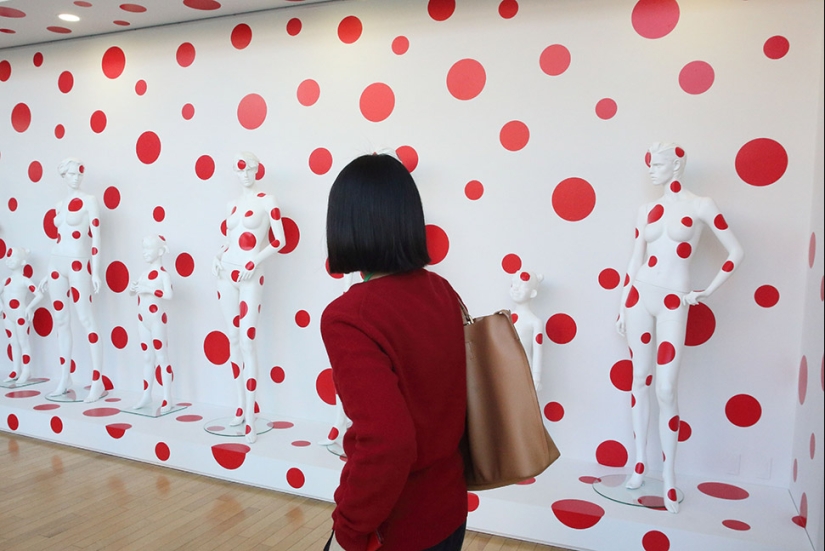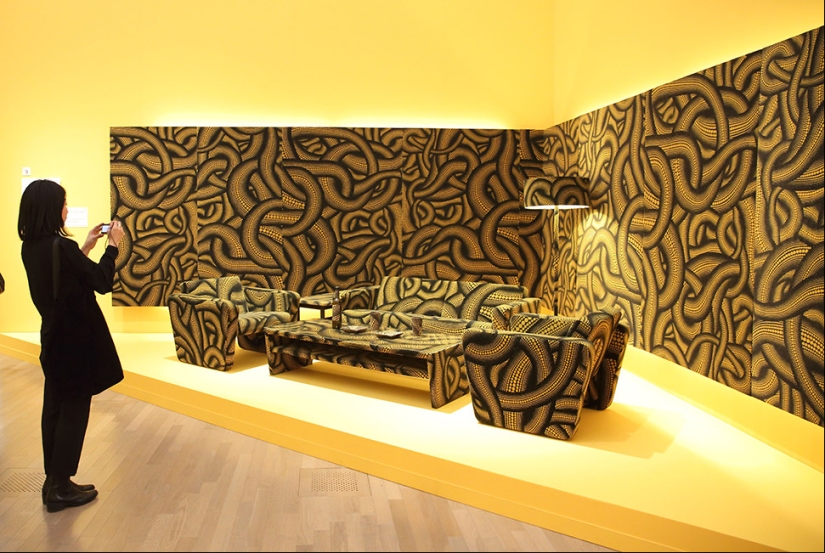The inhabitant of a mental hospital from Japan is the most expensive living artist
Categories: Asia | Celebrities | Design and Architecture
By Pictolic https://pictolic.com/article/the-inhabitant-of-a-mental-hospital-from-japan-is-the-most-expensive-living-artist.htmlYayoi Kusama is unlikely to be able to answer what formed the basis of her career as an artist. She is 94 years old, her art is recognized all over the world. Kusama's installations, charged with unreal drive, have long become a fashionable background for selfies. The phenomenon of her work is a mystery to many. From an outsider of the art world, she turned into the most commercially successful artist on the planet.

Kusama lives in Tokyo and has been voluntarily in a psychiatric hospital for more than forty years. Once a day she leaves her walls to paint. She gets up at three o'clock in the morning, unable to sleep and wanting to spend time usefully at work.

From nine to six, Kusama works in his three-story studio without getting out of a wheelchair. She can walk, but she's too weak. A woman works on a canvas spread out on tables or fixed on the floor. The studio is full of new paintings, bright works, strewn with small specks. The artist calls it "self—silencing" - an endless repetition that drowns out the noise in her head.

The headlines of articles about the artist rarely go without mentioning mental illness. Indeed, the features of the hallucinatory perception of the world caused by mental disorders formed the basis of Yayoi Kusama's creativity. It is based on the idea of repeating patterns – "infinity nets" and spaces covered with peas and phallic symbols transformed into some kind of coral reefs.
Her peas cover everything from Louis Vuitton dresses to buses in her hometown. Kusama's works regularly sell for millions of dollars and are found all over the world — from New York to Amsterdam. Exhibitions of the Japanese artist's works are so popular that measures are required to prevent crowding and riots. For example, in Hirshhorn, tickets to the exhibition are sold for a certain time in order to somehow regulate the flow of visitors.

But Kusama still needs outside approval. When asked in an interview whether she had achieved her goal by becoming rich and famous decades ago, she said in surprise:
Kusama was born in Matsumoto, in the mountains of Central Japan, in 1929 in a wealthy and conservative family that sold seedlings. But it wasn't a happy home. Her mother despised her cheating husband and sent little Kusama to spy on him. The girl saw her father with other women, and this caused her lifelong aversion to sex.

As a child, she began experiencing visual and auditory hallucinations. The first time she saw a pumpkin, she imagined that it was talking to her. The future artist coped with visions by creating repetitive patterns to drown out thoughts in her head. Even at such a young age, art became a kind of therapy for her, which she would later call "art medicine".

Kusama's mother was sharply against her daughter's desire to become an artist and insisted that the girl follow the traditional path.
In 1948, after the end of the war, Kusama went to Kyoto to study traditional Japanese nihonga painting with strict rules. She hated this kind of art.

When Kusama lived in Matsumoto, she found a book by Georgia O'Keefe and was amazed by her paintings. The girl went to the American Embassy in Tokyo, to find an article about O'Keefe in the directory there and find out her address. Kusama wrote her a letter and sent her some drawings, and to her surprise, the American artist replied to her.

Despite O'Keefe's warnings that young artists have a very hard time in the USA, not to mention young single girls from Japan, Kusama was unstoppable. In 1957, she managed to get a passport and a visa. She sewed dollars into her dresses to circumvent strict post-war currency controls.
The first stop was Seattle, where she held an exhibition in a small gallery. Then Kusama went to New York, where she was bitterly disappointed.
To make matters worse, Kusama found herself in utter poverty. An old door served as her bed, and she fished fish heads and rotten vegetables out of garbage cans to cook soup from them.

This difficult situation prompted Kusama to plunge even more into work. She began to create her first paintings from the "Infinity Net" series, covering huge canvases (one of them reached 10 meters in height) with mesmerizing waves of small loops that seemed to never end. The artist herself described them as follows: "White nets enveloping black dots of silent death against the background of the hopeless darkness of nothingness."

This obsessive-compulsive repetition helped to ward off neurosis, but it did not always save. Kusama constantly suffered from bouts of psychosis and ended up in a hospital in New York. Being ambitious and purposeful and happily taking on the role of an exotic Asian woman in a kimono, she joined the crowd of influential people in art and communicated with such recognized artists as Mark Rothko and Andy Warhol. Kusama later said that Warhol imitated her work.
Soon Kusama gained a certain degree of fame and exhibited in crowded galleries. In addition, the fame of the artist has become scandalous.
In the 1960s, when Kusama was obsessed with the polka dot pattern, she began to arrange happenings in New York: provoked people to strip naked in places like Central Park and the Brooklyn Bridge, and painted their bodies with polka dots.

A few decades before the "Occupy Wall Street" movement appeared, Kusama staged a happening in the financial district of New York, saying that he wanted to "destroy the men of Wall Street with a polka dot pattern." Around the same time, she began to cover various objects — a chair, a boat, a stroller —with phallic bulges.

Kusama has never been married, although when she lived in In New York, for ten years she had a marriage-like relationship with the artist Joseph Cornell.
Kusama became more and more famous for her antics: she offered to sleep with US President Richard Nixon if he stopped the war in France. Vietnam. "Let's decorate each other with a polka dot pattern," she wrote to him in a letter. Interest directly in her art was fading, she found herself in disgrace, and money problems began again.

News of Kusama 's escapades reached Japan. She was called a "national disaster", and her mother said that it would have been better if her daughter had died of an illness in childhood. In the early 1970s, the impoverished and fiasco-stricken Kusama returned to Japan. She registered in a psychiatric hospital, where she still lives, and sank into artistic obscurity.

In 1989 , the Center for Contemporary Art in New York arranged a retrospective of her work. This was the beginning of a slow, but revival of interest in the art of Kusama. She filled the mirror room with pumpkins for an installation that was presented at the Venice Biennale in 1993, and in 1998 a major exhibition was held at the MoMA Museum of Modern Art in New York. It was here that she once arranged a happening.

In the last few years, Yayoi Kusama has become an international phenomenon. The Tate Contemporary Gallery in London and the Whitney Museum in New York have held major retrospectives that have attracted huge crowds of visitors, and her iconic polka dot pattern has become very recognizable.

The artist is not going to suspend her work, but she began to think about her mortality.

Despite the commercialization of her art, Kusama is thinking about the grave in Matsumoto — not in the family crypt, she already got it from her parents — and how not to turn it into a shrine.

Recent articles

Victor Lustig is considered one of the most skillful and famous scammers in the world. He was arrested about 50 times and released ...

A small apartment is not a sentence! On the contrary, this is an occasion to turn on imagination and come up with ways to stylishly ...

Each of us has heard at least once that "breakfast is the most important meal of the day." Spreading this truth is the work of ...